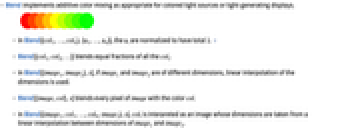Blend[{col1,col2},x]
gives a color obtained by blending a fraction ![]() of color col1 and
of color col1 and ![]() of color col2.
of color col2.
Blend[{col1,col2,col3,…},x]
linearly interpolates between colors coli as x varies from 0 to 1.
Blend[{{x1,col1},{x2,col2},…},x]
interpolates to give coli when x=xi.
Blend[{col1,col2,…},{u1,u2,…}]
blends all the coli, using fraction ui of color coli.
Blend[{image1,image2,…},…]
blends pixel values of 2D or 3D images imagei.


Blend
Blend[{col1,col2},x]
gives a color obtained by blending a fraction ![]() of color col1 and
of color col1 and ![]() of color col2.
of color col2.
Blend[{col1,col2,col3,…},x]
linearly interpolates between colors coli as x varies from 0 to 1.
Blend[{{x1,col1},{x2,col2},…},x]
interpolates to give coli when x=xi.
Blend[{col1,col2,…},{u1,u2,…}]
blends all the coli, using fraction ui of color coli.
Blend[{image1,image2,…},…]
blends pixel values of 2D or 3D images imagei.
Details

- Blend implements additive color mixing as appropriate for colored light sources or light‐generating displays.
- In Blend[{col1,…,coln},{u1,…,un}], the ui are normalized to have total 1. »
- Blend[{col1,col2,…}] blends equal fractions of all the coli.
- In Blend[{image1,image2},x], if image1 and image2 are of different dimensions, linear interpolation of the dimensions is used.
- Blend[{image,col},x] blends every pixel of image with the color col.
- In Blend[{image1,col1,…,coln,image2},x], coli is interpreted as an image whose dimensions are taken from a linear interpolation between dimensions of image1 and image2.
Examples
open all close allBasic Examples (4)
Scope (12)
Applications (2)
Use Blend to construct a ColorFunction from base colors:
Combine multiple images with different exposures into one image:
Properties & Relations (7)
The weights are always normalized, so that the sum becomes 1:
The position values are always sorted:
When colors are specified using the same color space, that space is used for interpolation:
When colors are specified using different color spaces, interpolation happens in the RGB space:
Lighter is a special case of Blend:
Darker is a special case of Blend:
ColorData contains a large number of predefined Blend colors called "Gradients":
Gradients can be called by their names only:
Polygon supports equal-weight blending of VertexColors:
Possible Issues (2)
Values outside of the 0, 1 range will be clipped:
In plot functions, use ColorFunctionScaling to control global scaling of variables:
Different colors can be given at a single position to generate discontinuities:
Interactive Examples (4)
Neat Examples (2)
Related Guides
Text
Wolfram Research (2007), Blend, Wolfram Language function, https://reference.wolfram.com/language/ref/Blend.html (updated 2014).
CMS
Wolfram Language. 2007. "Blend." Wolfram Language & System Documentation Center. Wolfram Research. Last Modified 2014. https://reference.wolfram.com/language/ref/Blend.html.
APA
Wolfram Language. (2007). Blend. Wolfram Language & System Documentation Center. Retrieved from https://reference.wolfram.com/language/ref/Blend.html
BibTeX
@misc{reference.wolfram_2025_blend, author="Wolfram Research", title="{Blend}", year="2014", howpublished="\url{https://reference.wolfram.com/language/ref/Blend.html}", note=[Accessed: 08-December-2025]}
BibLaTeX
@online{reference.wolfram_2025_blend, organization={Wolfram Research}, title={Blend}, year={2014}, url={https://reference.wolfram.com/language/ref/Blend.html}, note=[Accessed: 08-December-2025]}